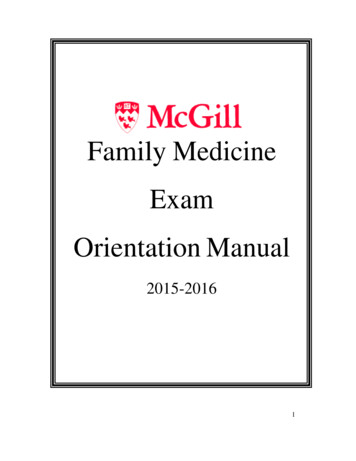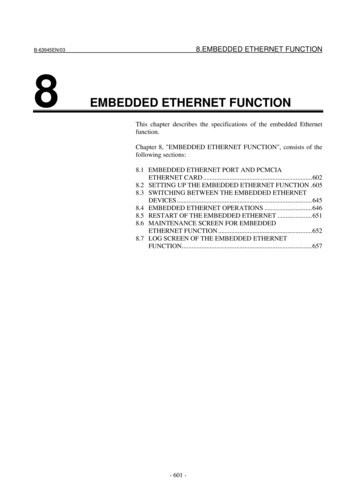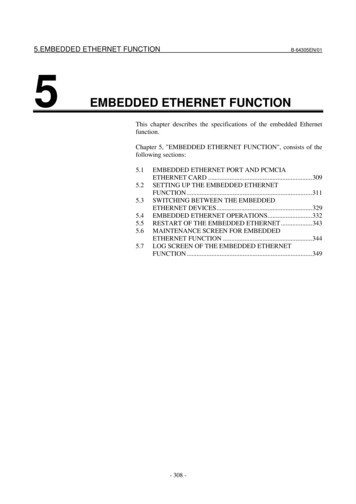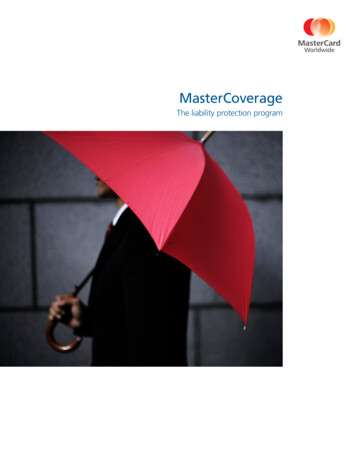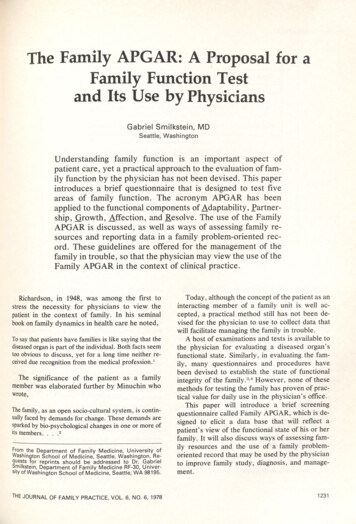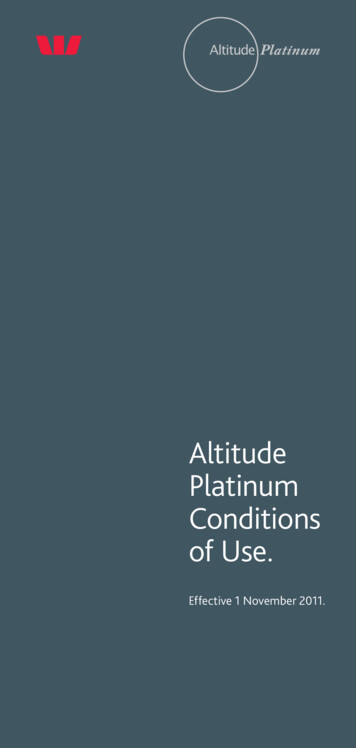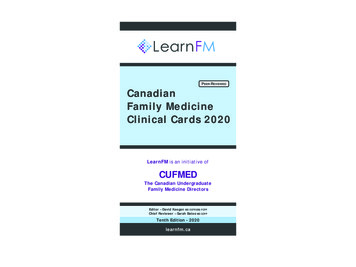
Transcription
PEER-REVIEWEDCanadianFamily MedicineClinical Cards 2020LearnFM is an initiative ofCUFMEDThe Canadian UndergraduateFamily Medicine DirectorsEditor – David Keegan MD CCFP(EM) FCFPChief Reviewer – Sarah Bates MD CCFPTenth Edition - 2020learnfm.ca
The editors, authors & reviewers have made everyattempt to ensure the information in the CanadianFamily Medicine Clinical Cards is correct. It isnevertheless possible that errors may exist.Accordingly, the source references and/or otherauthorities should be consulted to aid indetermining the assessment and management plansof patients.Clinical Cards are not meant to replace customizedpatient assessment nor clinical judgement. Theyare meant to highlight key considerations inparticular clinical scenarios, largely informed byrelevant guidelines in effect at the time ofpublication. The authors, editors & reviewers donot assume any liability for patient outcomeswhen these cards are used. They were created forclinical education purposes in Canada only.10th Edition September 1, 2020PRODUCTION ASSISTANTDanielle KissPrinted in Canada by Allegra PrintingLondon, ONallegralondonontario.cam.ca
LearnFM
Canadian Family Medicine Clinical Cards2020Table of ContentsAbdominal PainAnxiety DisordersAsthmaAsthma DevicesCancer ScreeningChest Pain – ER CareChest X-Ray InterpretationCommon InfectionsConjunctivitisGastroenteritisOtitis MediaSinusitisSore ThroatUrinary Tract Infection (UTI)Sexually Transmitted InfectionsComprehensive Family ercise PrescriptionsECG Rhythm Interpretation 1ECG Rhythm Interpretation 2ECG Morphology InterpretationFatigueFeverHeadacheHypertension AssessmentHypertension ManagementIschemic Heart Disease ManagementJoint Pain 1: ArthritisJoint Pain 2: Upper LimbJoint Pain 3: Lower LimbApproach to Limb InjuryLow Back PainMajor Health HistoryMajor Physical ExamMenopausePainPain AssessmentPain ManagementOpioid Care GuidancePalliative CarePrenatal CareRoutine Prenatal CareCommon Prenatal 3
Canadian Family Medicine Clinical Cards2020Table of ContentsPrenatal Care, continuedHypertension in PregnancyMajor Problems 20 WeeksObstetric AssessmentRourke Baby Record0 - 1 Month2 - 6 Months9 – 15 Months18 Months2 – 3 Years4 – 5 YearsSenior SnapshotSexual Health HistorySkin Conditions 1Skin Conditions 2Substance AddictionsType 2 Diabeteslearnfm.ca64656667697172737475767778798081
Canadian Family Medicine Clinical CardSandercock LEKeegan DAA12011www.learnfm.ca4Abdominal PainCommon Diagnoses“Abdominal pain NYD” is the most common diagnosis in all age groupsNextmostcommondiagnosesPediatricAdult Colic (Infants) Irritable Bowel Synd. Constipation (1-4 yrs)(IBS) Recurrent Abdo. Pain (4-9 yrs) Gastroenteritis IBS (9-12 yrs) Constipation Gastroenteritis Other viral infection UTIGeriatric IBS Diverticular Dz Constipation Gastroenteritis GI malignancyDiagnosing Irritable Bowel Syndrome (IBS)Consider using Manning Criteria: 3 or more of the following: pain relief with bowel movement passage of mucus more frequent stools with onset of pain sensation of incomplete evacuation loose stools with onset of pain abdominal distentionAND no red flags or family hx of organic bowel disease. (Likelihood Ratio: 2.9)If pt doesn’t meet the above criteria and IBS is high on DDx, consider the Kruis method which isbased on sx, sx duration, physician assessment, CBC, ESR, WBC, FOB. (Likelihood Ratio: 8.6). 2006 ROME III criteria has only fair to modest inter-rater reliability between experts and still needsvalidation.Physical Exam/ Investigations: Beyond the Abdomen vitals cardiac rhythm consider testicular or bimanual examRed FlagsFinding lungs DRE Beta HCG consider endomysial testing for celiacdz in child with chronic abdo. painTypicalAge/SexDx To Think AboutHPIWeight lossA, GGI MalignancyPain radiating to backA, GPancreatitis, AAAPain central and then RLQAnyAppendicitisPain radiating to groinBlood per rectum/melenaMaleAnyTesticular Torsion, Hernia, Renal ColicGI bleed (PUD, Varices, Diverticulitis), Meckel’s,Malignancy in elderlyCurrent antibiotics/steroidsPMHxCardiac hx incl Afib, HTNPrev abdominal surgeryTaking antipsychoticsSocial HxEtOHSexually activePhysical ExamChange in mental status RRShockAnyCan mask peritoneal symptomsGGA, GIschemic bowel, AAA, MIObstructionIleus, Obstruction or Toxic MegacolonA, GFemaleRisk factor for Pancreatitis, VaricesEctopic Pregnancy, STIsGP, GAnyInfection (particularly UTI)PneumoniaPerforated Viscus, GI Hemorrhage, SeverePancreatitis, MI, Sepsis (N, P)Severe pain out of keeping withfindingsA, EIschemic Bowel, PancreatitisRestless/writhingPulling up legs to chestAnyNBiliary or Renal Colic, Testicular TorsionVolvulus, IntussusceptionLower abdominal tendernessLLQ tendernessA adult G geriatric N neonateFemale Ectopic Pregnancy or Other GyneA,GDiverticulitisP pediatricKey References: Ponka D, Kirlew M . Top 10 differential diagnoses in family medicine: generalized abdominal pain. Can Fam Physician. 2007;53(9):1509. CayleyWE Jr. Irritable Bowel Syndrome. BMJ. 2005;330(7492):632. Ford AC, et al. Will the history and physical examination help establish that irritable bowelsyndrome is causing this patient’s lower gastrointestinal tract symptoms? JAMA. 2008;300(15):1793-805. Smucny J, et al. Abdominal Pain. Essentials of FamilyMedicine, 5th Edition, 2008. Chogle A, et al. How reliable are the Rome III criteria for the assessment of functional gastrointestinal disorders in children? Am JGastroenterol. 2010;105(12):2697-701.
Canadian Family Medicine Clinical CardA022013www.learnfm.ca5Anxiety DisordersGillGill HSHSKeeganKeegan DADAKEY ELEMENTS ON HISTORY (disorders must cause significant impairment)Generalized- excessive worry/anxiety about things in real lifeAnxiety Disorder -fatigue, concentration, irritability, muscle tension, “on edge”,(GAD)insomnia more days than not for 6 months-if 6 months, diagnosis is “adjustment disorder with anxious mood”Phobias- irrational and persistent fear triggered by actual or anticipated exposure tocertain situations or objects that are actively avoided- subsets: social anxiety disorder (fear of social situations), agoraphobia (fearof inability to escape), othersPost-traumatic- history of severe trauma* in past (rape, abuse, combat, MVCs, etc.)Stress Disorder- intense arousal from recurrent flashbacks; nightmares; avoidance of stimuli(PTSD)reminding of incident; attempts to numb emotions- Sx 1 month after trauma *severe event beyond normal exp.Panic Disorder- recurrent short unexpected periods of intense fear or discomfort(PD)- sx often short-lived; can peak in 10 min; may be: somatic (eg. chest pain,abdo pain), autonomic (sweating, palpitations, tachycardia), neurologic(paresthesias, tremor, dizziness), and/or psychiatric (feelings of impendingdoom)Obsessive- obsessions (intrusive thoughts/images recognized to be self- generated), e.g.fear of contaminationCompulsive- compulsions (repetitive intentional behavior), e.g. hand washingDisorder (OCD)INITIAL APPROACH TO ANXIETY DISORDERS1. history & focused physical exam to rule out other causes (e.g. asthma &dyspnea)2. consider: TSH, CBC, electrolytes, urinalysis, urine drug screen3. screen for common comorbidities (depression, substance abuse, chronic pain,suicidal ideation) and manage accordingly4. consider using structured tools to assess severity of anxiety at every visit(e.g. GAD-7 scale)5. review previous therapies used by pt, as it will guide treatment6. determine patient expectations for therapyGENERAL TREATMENT MEASURES (essential for successful treatment)Patient- anxiety is a normal stress rxn; disorder when excessive/inappropriateEducation - cycle of anxious thoughts, physical sx, and avoidance behaviour prolongsanxiety, and is increased by stress and maladaptive thoughts/habits- provide educational resource for patient (www.anxietycanada.ca)Lifestyle - balanced diet, exercise, sleep hygiene, alcohol/caffeine, stress- encourage relaxation techniques (meditation, deep breathing, yoga)Cognitive - goal: to pt overestimation of risk and exagg. of negative outcomeBehav.- key: patient must see that these beliefs are rarely, if ever justifiedTherapy- encourage exposure to anxiety provoking situations in a graded fashion- typically requires 6-8 sessions over 8-12 weeksOPTIONAL ADJUNCTIVE MEDICATIONS- start at low dose, slowly (q2-3wk), aimhigh (large dose needed for anxiety)- low half life drugs (e.g. paroxetine,venlafaxine) can cause withdrawal if dosemissed and if compliance is lowGADPhobia and PDPTSD and OCDSSRI, SNRISSRI, prn anxiolyticsSSRI, TCAsIF FIRST LINE THERAPY INEFFECTIVE- assess whether patient able to followthrough with therapy requirements- reconsider diagnosis (substance abuse,bipolar disorder, new stressor, organiccause)- ensure comorbidities are treated- add 2nd SSRI/SNRI or TCA- consider psychiatric consultKey References: Roy-Byrne P, et al. Brief intervention for anxiety in primary care patients. J Am Board Fam Med.2009;22(2):175-86. Ebell MH. Diagnosis of anxiety disorders in primary care. Am Fam Physician. 2008;78(4):501-2. Shearer S,Gordon L. The patient with excessive worry. Am Fam Physician. 2006;73(6):1049-56.
A032019www.learnfm.caCanadian Family Medicine Clinical CardCheck-Uprhinosinusitis (infxs. or allergic)upper airway obstruction (infxs,intrinsic, extrinsic)foreign body; aspiration (food,gastric contents)bronchiolitispneumonia, atelectasis, TB,pertussispertussisbronchopulmonary dysplasiacongenital pulm. artery malform.;bronchiectasis; cystic fibrosisprimary ciliary dyskinesiaGERDeosinophilic esophagitis;swallowing problem /- aspirationimmune disorderpulm. edema 2º to myocarditis,pericarditis, congen. cardiac dz6 y.o. - ADULTS3 ways to diagnose:1. Reversible Airway Obstruction on Spirometry (Preferred) FEV1/FEV (vs. norms) and 11% in FEV1 after SABA or ICS course2. Peak Expiratory Flow Variability (Alternative) 20% improvement in PEF with SABA or ICS course(or in adults, 8% variability during the day, or 20% over multiple days)3. Positive Challenge Test (Alternative)positive methacholine challenge test, orpositive exercise challenge ( 10% in FEV1 following exercise)Key References: Lougheed et al. Canadian Thoracic Society Asthma Management Continuum—2010 Consensus Summary forchildren six years of age and over, and adults. Can. Resp. J. 2010.17(1);15-241. Assess control: good control if following criteria are met no daytime symptoms no nighttime symptoms normal physical activity mild/infrequent exacerbations no school/work absences 4 doses SABA / wk (not counting 1 FEV1 or Peak flow 90% pers. bestdose/day for exercise sx)2. Observe & assess inhaled drug technique (use mask chamber if 6 years old)Routine Management1. Develop Asthma Action Plan with patient; involve asthma educator ifavailable2. Address co-morbidities: rhinitis, GERD, obesity3. Environmental control: smoking cessation & avoidance dust/particle exposure reduction allergy testing & allergen avoidance4. Maintenance Drug therapy: First line: All patients should have PRN shortacting β2-agonist (eg. salbutamol) AND inhaled corticosteroids (ICS)(ICS starting dose should be customized to patient’s initial severity and age)Typical Age DAILYBecloFluticasone Budesonide CiclesonideDose Ranges equivalency methasone(turbuhaler (not for 6(years)(Qvar device)device)years old)Ultra low100ug100-125ug 100ug100ugLow dose200ug200-250ug 200ug200ugMedium400ug500ug400ug400ugHigh 400ug 500ug 400ug800ugIf insufficient control, consider: ICS dose adding long-acting β2-agonist or leukotriene antagonist exploring alternate/comorbid conditions 111.Documentation of Airflow ObstructionPreferred: documented wheezing and/or other signs of obstruction by MD orother health professional.Alternative: convincing parent/ guardian report of wheezing or otherobstructive symptoms.2. Documentation of Reversibility of Airflow ObstructionPreferred: documented improvement of wheezing and/or other signs ofobstruction by MD or other health professional, in response to SABA /steroid.Alternative 1: convincing parent/guardian report of improvement ofobstructive symptoms in response to 3 mo tx with ICS (and PRN SABA)Alternative 2: convincing parent/guardian report of improvement ofobstructive symptoms in response to SABA3. No Clinical Evidence of Alternative Diagnosis0–6CHILDREN 6 y.o.3 key elements to diagnosis:6-11DiagnosisClues for Alternative Diagnoseschronic nasal dischargestridor; loud breathing whencrying, eating, supine, resp infxnacute onset cough/wheeze wheneating or playing; recurrentpneumonia (same location)first wheeze and child 1y.o.sick contacts, xray with focalfindingsparoxysms of cough /- whoopprem. birth, prolonged O2 /- ventsx since birth, ve xray, recurrentpneumonianeon. resp. distress, chronic dailycoughcough when supine, eatingdifficulty feeding, coughwith/post feedingrecurrent, persist. infectionsmurmur, heart failure, FTT,tachypnea, hepatomegaly7AsthmaKeegan DAKim GThornton TH5. Exacerbation:[A] determine (and resolve if possible) underlying cause(s): tobacco/irritant/allergen exposure respiratory infection medication/administration errors[B] give oral systemic steroidsKids: prednisone (or prednisolone) 1-2 mg/kg (up to 50mg/day) x 5 daysor dexamethasone 0.3-0.6 mg/kg x 1-5 daysAdults (and kids 50kg): prednisone 50mg daily x 5 daysEmergency Management-O2 if hypoxic; activate EMS & arrange transportation to EDsalbutamol by chamber mask (or nebulizer); may require back-to-back dosingsystemic steroids if initial SaO2 96% (children), 94%(adults)consider ipratroprium bromide, MgSO4- if deteriorating, rule out pneumothorax and upper airway obstruction consider IV β2- agonist, inhalational anaesthetics, intubationDucharme FM, Dell SD, Radhakrishnan D, et al. Diagnosis and management of asthma in preschoolers: A CanadianThoracic Society and Canadian Paediatric Society position paper. Can Respir J. 2015;22(3):135-143.
A32013www.learnfm.caCanadian Family Medicine Clinical Card8Asthma DevicesChadha NGKeegan DAHow to ChooseDryPowderedMetered DoseInhaler (MDI)Device TypeMDI mouthpiecespacerMDI Mask spacerYes NoNoYesNoNoNoYesNo NoNoYesNoNoTurbuhalerYes NoYesNoNoYesNoDiskusYes YesYesNoYesNoNoHow to UseMetered Dose Inhaler (MDI)Device TypeInstructions(1) Remove cap and shakeMDI (2) Insert MDI into spacermouth- (3) Breathe out and seal lips around mouthpiecepiece(4) Press down and THEN take slow deep breath;spacerhold for 10 sec(5) Brush teeth or gargle/spit water after use(1)MDI (2)mask (3)spacer(4)Remove cap and shakeInsert MDI into spacerPut mask against face (do not cover eyes)Press down and take 6 normal breaths (usemouth to inhale)Device Care- Clean bysoaking in soapywater- Let device airdry aftercleaning- Replace cap onplastic sleeve tostore deviceMDI(1) Remove cap and shakealone** (2) Breathe out and seal lips around mouthpiece(3) Press down as you breathe in slowly(4) Hold breath for 10 sec then breathe outslowly(5) Brush teeth or gargle/spit water after useDry Powder**(not recommended except for 3M device)Turbuhaler(1) Twist open and turn and click once- Clean with dry(2) Breathe out fully and put turbuhaler in mouthcloth(do not blow into device)(3) Deep breath in and hold for 10 sec- Store at- do NOT shake deviceambienttemperatures(1) Push open and slide and clickDiskus (2) Breathe out fully and put diskus in mouth (donot blow into device)- Keep device dry(3) Deep breath in and hold for 10 seconds- do NOT shake deviceKey References: Lougheed MD, et al. Canadian Thoracic Society Asthma Management Continuum—2010 Consensus Summaryfor children six years of age and over, and adults. Can Resp J. 2010;17(1), 2010 15-24. Becker A, et al. Summary ofRecommendations from Canadian Pediatric Asthma Consensus Guidelines, 2003. CMAJ. 2005;173(6 Suppl).
Canadian Family Medicine Clinical CardCanadian Task Force onPreventative Health CareA19/20/21 2016www.learnfm.ca9Cancer ScreeningGRADE Recommendation LegendA strong recommendation for an action or intervention (recommend).A weak recommendation for an action or intervention. *A weak recommendation against an action or intervention. *A strong recommendation against an action or intervention (do not recommend).* Clinicians should discuss benefits and harms with patients in a shared decision-makingprocess, incorporating individual values and preferences.Breast Cancer (2011)Recommendations apply to women without personal history of breast cancer, breastcancer in first degree relatives, BCRA1 or 2 mutation, or prior chest wall radiation.Screening with mammography every 2-3 years:40-49 years50-69 years70-74 yearsScreening with MRI, clinical breast exam, self breast exam (not recommended):All agesCervical Cancer (2013)Recommendations apply to women who are, or who have been, sexually active,without symptoms of cervical cancer, previous abnormal screening results, and thosewithout a cervix (e.g., hysterectomy) and immunosuppressed.Screening with PAP test every 3 years: 20 years20-24 years25-29 years30-69 years 70 yearsColorectal Cancer (2016)Recommendations apply to adults without previous colorectal cancer, polyps, IBD,signs or symptoms of CRC, history of CRC in one or more first degree relative, orhereditary syndromes with increased CRC risk.Screening with fecal occult blood testing (FIT or gFOBT) every 2 years OR flexiblesigmoidoscopy every 10 years:50–74 years60-74 years 75 yearsScreening with colonoscopy:All agesLung Cancer (2016)Recommendations apply to adults with at least a 30 pack year history who currentlysmoke OR who quit in the last 15 years.Annual screening with low-dose computed tomography (LDCT) up to three consecutiveyears:50-74 yearsAll other adultsScreening with chest x-ray with or without sputum cytology:All agesOvarian Cancer (2016)Recommendations apply to asymptomatic, nonpregnant,adult women.Screening for noncervical cancer (including ovarian cancer), pelvic inflammatorydisease or other gynecological conditions with a pelvic examination:All agesThe US Preventive Services Task Force has reviewed screening for ovarian cancer(e.g., using transvaginal ultrasound) and has not found evidence of its effectiveness.Prostate Cancer (2014)Recommendations apply to men not previously diagnosed with prostate cancer andincludes men with lower urinary tract symptoms (e.g., nocturia) or with benignprostatic hyperplasia (BPH).Screening with prostate-specific antigen (PSA test:) 55 years55-69 years 70 yearsFor information on the harms/benefits, patients values/preferences and patient educationmaterials for each service, please visit www.canadiantaskforce.ca
Canadian Family Medicine Clinical CardElzinga KEKrejcik VHWalker IKeegan DAA42011www.learnfm.ca10Chest Pain – ER CareVitals requiring emergent care & transfer to ER Airway obstruction RR 10 or 29Symptoms O2 sats 92% Pulse 50 or 120 Systolic BP 90mmHg GCS 12(Danger signs in red)Diagnosis MI Ischem PE Pneum Arryth Aortic Pneum Myopa COPD Perica Myocar Costociaothoramia Dissect oniathy/Asth rditisditis hondrixionma1tisSymptomFatigueIn women or the elderly, treat as a surrogate symptom of chest painAbrupt onset Crescendo 2 3 4symptomsConstant pain 5 Dyspnea 6 6 Pain 30 s.Not a concern unless has DM (neuropathy can mask signs/symptoms)With exercise Pleuritic pain 7Cocaine use Anxiety/panic Can be secondary to the Dx or the cause of the chest pain itself1 Especiallyrelevant in children. 2Impending MI. 3 Worsening myopathy.COPD or asthma. 5Radiating to back is classic.due to 2º heart failure. 7With pleural inflammation4 Worsening6DyspneaMYO. INFARCTMYOCARDITISInv: Serial ECGs,troponin, imagingTx: ASA, oxygen,nitro, morphine,β-blocker,heparin, considerPCI. For STEMI:thrombolysis/PCI.Inv: CXR, ECG,bloodwork (CBC, ESR,troponin), echo.Tx: Supportive care,anticoag, restrictphysical activity, lookfor underlying causeCARD. ISCHEMIAInv: ECG, troponinTx: If crescendoor new onsetASA, oxygen,nitro, anticoag; ifknown and stable,ensure ASA; seeischemia card.ARRYTHMIAInv: ECG, echo,rhythm strip,electrophysiologystudies.Tx: Dependent onrhythm; look forunderlying cause.PE: WELLS CRITERIAPointsClinical signs/sx of DVT3Other dx less likely than PE3Heart rate 100/minute1.5Immob. or surgery in past 4 wks1.5Previous DVT or PE1.5Hemoptysis1Malignancy1PNEUMOTHORAXTotal points: 6 points high risk; 2 to 6Inv: CXR (inc. expir.) points mod. risk; 2 points low riskTx: Heimlich valve;Inv: Very low risk: Patient 50 y.o.,chest tube if 1 PTXWells scores 0, oxygen sat 94%, and nowith sx and/or 20%hormone use do not invest. for PE.collapse.Low/Moderate Risk: ELISA D-Dimer If-ve, no PE. If , proceed as for high risk.COSTOCHONDRITISHigh risk: CXR If -, VQ scan or CTInv: Diagnosis ofarteriography. If VQ or CT -, no PE.exclusion.Tx: Acetaminophen or If CXR or VQ or CT , treat. Ifnondiagnostic or still high suspicion,NSAIDsadditional testing required.AORTIC DISSECTIONTx: AnticoagulationInv: CXR, ECG,PERICARDITISTEE/CT/MRI.Inv: ECG. If low BP: TEE or CT or MRI.Tx: Urgent surgicalPericardiocentesis (for dx or tx).consultation & controlTx: ASA. 2nd line: NSAIDs orBP.glucocorticoid (prednisone).Key References: Laird C, Driscoll P, Wardrope J. The ABC of community emergency care: chest pain. Emerg Med J. 2004;21(2):226-32. Tapson V. Acute Pulmonary Embolism. NEJM. 2008;358:1037-52. Lee T, Goldman L. Evaluation of the patientwith acute chest pain, NEJM. 2000;342:1187-95. Kline JA, Mitchell AM, Kabrhel C, Richman PB, Courtney DM. Clinical criteriato prevent unnecessary diagnostic testing in emergency department patients with suspected pulmonary embolism. J ThrombHaemost.2004;2(8):1247–55.
Canadian Family Medicine Clinical CardA3/A4/A62013www.learnfm.ca Following up known pulmonaryCommunity CXR Indications:diseases Symptomatic pts with cardiac Evaluating malignancies (staging,or respiratory symptomsdetermining extent of spread)1. Decide if the CXR quality issuitable for interpretation:ID, Date Make sure you have the right CXR. Know when the X-ray was taken, tocompare sequential CXRs for the pt.13Chest X-Ray InterpretationYu YSpaner SJKeegan DA2. Analyze Frontal (PA/AP) CXR:Bones (inspect while counting ribs):Inspect for fractures, lesions (lucenciesor densities in the bone), or ribnotching (small grooves along the edgesof the ribs, suggestive of aorticcoarctation).Symmetry: are findings similaron both left and right sides?Pleura: Assess for any pleurallines (suggestive ofpneumothorax), masses,thickening, or calcification.Lung fields – Assess: Degree of whiteness Equivalency between right and left sides Opacifications/Infiltrates Presence of Kerley A/B lines Lung apices (above clavicles). Vasculature (size, position, and whethervascular markings run to the lung periphery)Imaging technique: AP or PA?- Assume PA unless told otherwise.- PA: clavicles usually more V-shaped.- AP: clavicles usually more horizontal.- In babies, AP view is common.- Only assess heart size on PA view (APprojection artificially magnifies heart).If infiltrates present, note pattern:- Lobar, cloud-like densities with airbronchograms: alveolar/air-space disease (akaconsolidation); suggests pus (i.e. pneumonia),blood, water, cells, or protein within alveoli.- Net-like, reticular: suggests interstitial lungdiseases (upper-lobe predominant: inhalationallung injuries; lower-lobe predominant:aspiration, asbestosis, sarcoidosis, etc).Rotation/Centering- CXR is centered when spinous processesare midway between clavicular ends.- If not centered, normal anatomy can bemisinterpreted (i.e. tracheal shifts).Trachea:- Find air column, check for tracheal deviation(tension pneumothorax or pleural effusion).- If a patient is intubated, the endotrachealtube tip should ideally be 4cm above the carina.Adequate inspiration? Count Ribs!- Good 8-10 posterior ribs visible abovediaphragm (Remember: ribs 1 2 overlap).- Inadequate inspiration can be misinterpreted (i.e. as interstitial lung disease).Hilum:- Contains 1) pulmonary arteries/veins, 2) mainstem bronchi, 3) lymph nodes.- Enlarged? (if hilum contour is straight orconvex instead of concave, hilum is enlarged).- Hilum Shifted? Asymmetrical?- Unilateral hilar enlargement: 95% malignantAdequate exposure?- Exposure adequate when intervertebraldiscs can be just barely seen through thecardiac shadow (can adjust digitally).- Under-exposure creates abnormalwhiteness on CXR; over-exposure (x-raydarkening) may hide pathologies.Costo-phrenic angles- Blunted pleural effusion 200-400mL.- Wide flat diaphragm; suggests airtrapping due to obstructive lung diseases.Heart:- Size (normal cardiothoracic ratio 0.5 on PAfilm), shape, and location within mediastinum.Normal PA CXR (male)Hemi-Diaphragms (Right and Left)- If flat: COPD, asthma exacerbation, foreign body- Air under R hemidiaphragm: perforated viscous- Blurred edge of diaphragm: lower lobe airspace disease- Hemi-diaphragm height: normally R L (liver underneath)- If one side abnormally higher: volume loss (atelectasis)Key References: Raoof S, et al. Interpretation of plain chest roentgenogram. Chest. 2012;141(2):545-58. Pineda V, et al.Lesions of the cardiophrenic space: findings at cross-sectional imaging. RadioGraphics. 2007;27(1):19-32Cardiac Shadows (Right and Left):- R cardiac shadow R atrium.- L cardiac shadow (top to bottom) aorticarch, L pulmonary artery, L ventricle.- Assess contour, shape, size, and location.- White blurring of any cardiac border suggestsairspace disease of upper or middle lung lobes.Cardio-phrenic angles- Blunted tumor masses (lymphoma, othermediastinal tumors), pericardial fat, pericardialcysts, cardiophrenic space varices,diaphragmatic hernia.Kivrak AS, et al. Differential diagnosis of dumbbell lesions associated with spinal neural foraminal widening: imaging features.Eur J Radiol. 2009;71(1):29-41
Canadian Family Medicine Clinical CardA3/A4/A62013www.learnfm.ca3. Analyze lateral CXR projection:Retrosternal Clear Space:- If opacified, consider “4 Ts” (in order ofcommonality in adults): 1) Thymoma, 2)Terrible lymphoma, 3) Teratoma, 4) ThyroidtumorHilum:- Look for changes (enlargement, shifts,asymmetries) in pulmonary vessels, mainstem bronchi, and lymph nodes.- Extra opacification around pulmonaryvessels and bronchi hilar lymphadenopathy.4. Important notes to keep in mind:Mediastinum:- Note posterior para-tracheal tissueline between the anterior trachea &the posterior esophagus (betweenwhite arrowheads): if 3mm, can ruleout lymphadenopathy.The retro-cardiac space is blocked - Findings that require immediate attention:from view in the frontalprojection. Lateral projections can Tracheal Shift: may indicate a tensionvisualize this hidden anatomy, andpneumothorax on the side opposite to theis also a better reflection of totaltracheal shift. If suspected on Hx/exam,lung volume.don’t do CXR; immediately decompress. Free air under R hemi-diaphragm: bowelperforation, urgent surgery consultneeded. (Note that air under L hemidiaphragm is usually the gastric bubble) Massive cavitations & infiltrates:especially in upper lobes, in the context ofcough & fever: suspect activetuberculosis, isolate patient and work upto establish diagnosis.Spinal column:- Assess vertebral bodies for densities andabnormal shapes or compressions.- Assess intervertebral disc spaces: if notwell-defined, may indicate discitis.- Assess neural foramina (holes betweenvertebral processes). If enlarged: likely tumoror cyst. If narrowed: likely bony enlargementimpinging on spinal nerves. Complete white-out of lung fields: severepulmonary edema, stabilize and transportfor definitive ER/ICU care.- Most common CXR false-negatives (realfindings that were not detected): Airspace disease (i.e. consolidation) Apical and retro-cardiac densities Solitary pulmonary nodules Mediastinal widening Cardiomegaly, changes in heart contourClear space posterior to heart:- If opacified: consolidation, atelectasis,enlarged vessels, masses, or hiatus hernias.Diaphragm:- Flat if height above anterior-posteriorcostophrenic angle “line” is 2.7cm.- Flat diaphragm lung hyperinflation due toairway obstruction (asthma, COPD).Costo-phrenic angles- Small pleural effusions best picked up withlateral projection (most commonly due tocongestive heart failure).15Chest X-Ray InterpretationYu YSpaner SJKeegan DA- Ask for previous CXRs to track CXRchanges, especially to monitor solitarypulmonary nodules for any changes.- Lower lung lobes can normally appear to beopacified by both breast and fatty tissue.Normal Lateral CXR (male)Other CXR Types / Views:- An AP frontal CXR is done for pts who - Expiratory View is done to accentuate: Air trapping: localize area of obstructioncan’t stand (i.e. quite ill, babies), and Pneumothoraxwhen a portable CXR is needed. Note Do not confuse expiratory views forthat the AP view 1) magnifies the heartpulmonary vasculature congestion,and 2) may shrink apparent lung volume.restrictive lung disease, or pneumonia.Key References (continued from previous card): Petinaux B, et al. Accuracy of radiographic readings in the emergencydepartment. Am J Emerg Med. 2011;29(1):18-25. Gatt ME, et al. Chest radiographs in the emergency department: is theradiologist really necessary? Postgrad Med J. 2003;79(930):214-7- Right: NormalPA CXR- Far Right:same patient,expiratory CXRAll images courtesy of Alberta Health Services RepositoryKlein EJ, et al. Discordant radiograph interpretation between emergency physicians and radiologists in a pediatric emergencydepartment. Pediatr Emerg Care. 1999; 15(4):245-8. Kuritzky L et al. Interpretation of chest roentgenograms by primary carephysicians. South Med J. 1987 Nov; 80(11):1347-51.
Canadian Family Medicine Clinical CardBurles KVaughan SDKeegan DAA102019www.learnfm.ca16Con
Canadian Family Medicine Clinical Cards 2020. Table of Contents. learnfm.ca. Prenatal Care, continued. Hypertension in Pregnancy 64. Major Problems 20 Weeks 65. Obstetric Assessment 66. Rourke Baby Record 67. 0 - 1 Month 69. 2 - 6 Months 71. 9 – 15 Months 72. 18 Months 73. 2 – 3 Years

